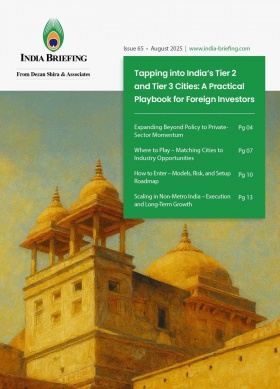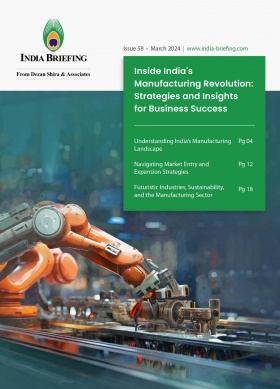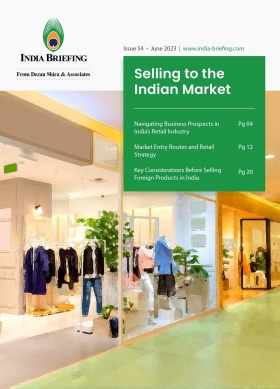India’s Luxury Market Potential for Italian Brands
Listen to article summary
Explore India’s fast-growing luxury retail market, with insights on top cities, FDI, sourcing, and opportunities for Italian luxury brands.
Across India’s bustling metros and rising new cities, a new generation of consumers is embracing luxury with confidence and curiosity – turning the country into a pivotal growth story for Italian fashion houses and design-led brands.
What was once a niche market catering to legacy elites is now transforming into one of the most vibrant luxury ecosystems in Asia. India’s young, well-travelled, and digitally connected consumers are rewriting what prestige means. They prize experience over excess, authenticity over ostentation, and narrative over mere logos. For Italy’s storied maisons – synonymous with artistry, heritage, and sensual craftsmanship – this cultural evolution aligns perfectly with their DNA.
According to Euromonitor International, India’s luxury goods market is expected to touch US$12.1 billion in 2025, placing it among the top global growth engines. The country’s demographic edge, expanding affluent class, and rising confidence in local retail experiences are reshaping how and where Indians buy luxury.
India’s new luxury consumer: Young, digitally-savvy, and experience-driven
In today’s India, luxury consumption is being led not by old wealth but by a younger generation of achievers – start-up founders, professionals, creative entrepreneurs, and second-generation business leaders. These consumers see luxury as a reflection of lifestyle and identity rather than social validation.
They gravitate toward craftsmanship, sustainability, and bespoke service – values that mirror Italian brand ethos. Premium automobiles and experiential luxury have become leading indicators of this trend. Bain & Company’s Luxury 2024 Outlook notes that “absolute luxury” and experience-based consumption remain robust even as mass markets cool.
Supercars like Lamborghini and Ferrari are registering record sales among first-time Indian buyers under 40. In beauty and fashion, digital platforms such as Nykaa Luxe and Tata CLiQ Luxury have democratized access to prestige products, while maintaining an aura of exclusivity. Fine-watch and jewelry sales – forecast to grow 11-12 percent annually – show that both male and female consumers are upgrading their lifestyles across categories.
India’s luxury story is coming into its own. With reforms simplifying operations, infrastructure expanding, and consumers embracing authenticity, the foundations for long-term growth are firmly in place. For Italian houses, the message is simple: those who enter early, localize wisely, and invest emotionally will not just sell in India – they will belong here. – Koushan Das, Manager, Business Intelligence, Dezan Shira & Associates
Top cities for luxury retail in India: Market mapping and leasing trends
The geography of luxury in India tells a story of rapid urban transformation. New shopping districts and luxury corridors are redefining the skyline of its cities – each promising a different retail narrative.
The flagship cities: Mumbai, Delhi, Bengaluru
Mumbai: At the heart of India’s financial capital, Jio World Plaza in the Bandra Kurla Complex has become the symbol of modern Indian affluence. Beneath its marble atriums, Italian labels share space with global icons, while art installations and patisseries turn shopping into theatre. Nearby, Palladium Mall in Lower Parel continues to attract the city’s established elite. According to CBRE, Mumbai’s total retail leasing in Q3 2025 reached 0.59 million sq ft, with fashion contributing 40 percent of transactions and top-mall vacancy below 5 percent.
Delhi NCR: The capital’s DLF Emporio and The Chanakya remain India’s couture nucleus, while Khan Market – with annual rents near US$229 per sq ft – holds its title as one of the world’s most expensive high streets. For Italian brands, Delhi’s blend of heritage and diplomacy offers both gravitas and visibility.
Bengaluru: South India’s technology powerhouse has evolved into a luxury hub in its own right. UB City and Phoenix Mall of Asia cater to globally exposed professionals whose spending habits rival those of Delhi and Mumbai.
Also Read: Emerging Technologies Supporting Your India Retail Strategy: Location Analytics
India’s emerging luxury hubs: The second wave
Beyond the metros, new cities are rising. Hyderabad, with its thriving tech and biotech sectors, and Pune, home to industrial wealth and education elites, are now considered India’s next luxury frontiers. Affluent neighborhoods such as Jubilee Hills, Banjara Hills, and Koregaon Park, host boutique stores, trunk shows, and pop-up collaborations. Ahmedabad and Chandigarh are also seeing premium mall developments targeting HNWI clusters.
Where Italian craft meets Indian culture
- Fashion and couture
In India’s US$75 billion wedding and festive economy, couture is less a purchase and more a performance. Italian ateliers that adapt their artistry to India’s celebratory rhythms – embroidered detailing, jewel-tone palettes, or made-to-measure bridal wear – will find themselves not just selling garments but crafting memories.
- Leather goods and footwear
Small leather goods and accessories are often the first point of entry into luxury. Italian leather craftsmanship, long admired for its quality and finish, appeals strongly to India’s aspirational buyers. Positioning these as lifestyle statements rather than indulgences helps broaden the market.
- Watches and jewelry
India’s fascination with timepieces and ornamentation makes this segment timeless. For Italian watchmakers and jewelers, the key lies in highlighting design lineage while offering robust after-sales service – a differentiator in building long-term credibility.
- Automobiles
Supercars remain the pinnacle of luxury aspiration. Italian automakers can deepen presence through experience centers and CKD (completely knocked-down) assembly to manage duties. As India’s road infrastructure modernizes, luxury mobility is poised for double-digit expansion.
- Prestige beauty
Beauty continues to democratize luxury access. Nykaa Luxe’s nationwide reach and Galeries Lafayette Mumbai’s upcoming debut in the heritage Turner Morrison Building in the city’s Fort area provide Italian beauty houses instant exposure to India’s high-income demographic.
Spotlight: India’s gold and luxury jewelry market
Estimates for India’s jewelry market in FY 2024-25 cluster around US$85-91 billion, with mid-single to low-double-digit growth expected through 2030-33. Organized chains are gaining share quickly (roughly mid-30s percent in FY25 vs ~22 percent in FY19), helped by regulation and consumer trust in formal retail.
Further, India is the third-largest jewelry exporter globally and a key manufacturing hub.
Key regulations:
- FDI in single-brand retail: Up to 100 percent via the automatic route, enabling wholly owned Indian entities and boutique rollouts for European and Italian companies.
- Goods and services tax (GST) of 3 percent on gold jewelry (plus applicable making charges treatment), a stable, widely referenced benchmark for pricing and invoicing.
- New International Financial Services Center Authority (IFSCA) rules issued in October 2025 broaden the eligibility for importing precious metals through the India International Bullion Exchange (IIBX) by updating the criteria for “Qualified Jewelers”. The new rules also streamline import operations under the India-UAE Comprehensive Economic Partnership Agreement (CEPA) by consolidating previous circulars into a single, comprehensive framework, making it easier for both Qualified Jewelers and Tariff Rate Quota (TRQ) holders to import gold and silver. This lowers friction for qualified jewelers sourcing bullion and supports compliant imports.
- Hallmarking/ Hallmark Unique Identification (HUID): BIS hallmarking with a unique HUID is now mandatory across 361 districts and extends to 9-karat pieces, sharpening trust and traceability in premium retail.
- Budget 2025 cut the gold import duty from 15 percent to 6 percent, encouraging formal imports and easing input costs for compliant retailers. Other rules and taxes, like a 3 percent GST, are also applicable.
Target consumer segments:
- Occasion and bridal couture: Ultra-high-value sets in 18-22k gold with gemstones, bespoke design, and heirloom restoration services. Despite volume dips, wedding cycles anchor spend.
- Modern daily luxury: Lightweight 9-14k gold, demi-fine lines, and Lab-Grown Diamonds (LGD) set pieces for younger, urban professionals; omnichannel journeys led by flagship stores and appointment-only salons.
- Investment-adjacent prestige: High-purity gold jewelry where aesthetic meets perceived store-of-value; limited editions and numbered pieces thrive when gold’s narrative is strong.
- Supply chain: Consider limited local finishing or assembly for agility, while importing critical components under CEPA/IIBX regimes where economical.
The state of Maharashtra has launched its Gem and Jewellery Policy 2025 in an effort to compete with hubs like Surat in the adjacent state of Gujarat. A significant project will be the upcoming India Jewellery Park in Navi Mumbai, expected to be Asia’s third largest. Maharashtra’s policy will support the entire gem and jewelry industrial ecosystem, including manufacturing, exports, and skill development. Financial incentives include relief on electricity bills and GST for the next five years.
Format mix:
a) Flagship maison in luxury malls/high streets of Mumbai (BKC, Palladium), Delhi (DLF Emporio/Chankayapuri), Bengaluru (UB City), and Hyderabad (Banjara Hills).
b) Private by-appointment salons for high jewellery and bridal trousseau curation; pop-ups during wedding and festival seasons when conversion spikes.
c) Omnichannel for discovery, appointment booking, and after-sales (resizing, re-polish, exchange).
City rollouts: Prioritize Mumbai–Delhi–Bengaluru–Hyderabad for early payback; expand to Pune, Ahmedabad, Chandigarh, Kochi, Surat, and Lucknow for affluent tier-2 growth aligned to organized chains’ footprints.
Sourcing and compliance: Leverage IIBX/CEPA channels for bullion sourcing; maintain BIS-compliant hallmarking workflows with HUID to align with consumer protection norms and avoid enforcement risk.
Pricing architecture: Anchor collections at three ladders: lightweight entry (9–14k), signature 18k design lines, and high jewelry in 18–22k; communicate GST and hallmarking transparently to reinforce trust.
Design grammar: Merge Italian craftsmanship with India-specific motifs and wearability (convertible pieces, detachable pendants, modular bangles).
Retail partnerships: Shop-in-shops with leading luxury retailers or curated multi-brand destinations to test formats before standalone expansion.
After-sales excellence: Lifetime service, certified buy-back/exchange, and transparent weight/making-charge disclosures are competitive must-haves in India’s trust-centric market.
Foreign jewelry brands cannot win in India by simply exporting the European product catalogue and wait for orders. You must commit, and localize the product, let’s say “Indianize” it by first understanding stylistic peculiarities and embedding them in the design. Second, understanding where the flow is: the wedding theme. Because it is for weddings that at least 50 percent of imported foreign jewelry is sold, meaning it moves more money than the entire luxury-fashion market. With an annual growth rate of 5-10 percent, India, which by the way is the second largest consumer of gold globally, after China, now accounts for 24 percent of the global jewelry market. To name one Italian giant in the industry, Bvlgari, we know that they will open at least 10 more boutiques in the next five years. This has got to mean something. But it’s not only big names: there are the goldsmith power houses in the Vicenza or Arezzo area – where I am as I make this statement and from where over 45 percent of Italy’s gold export are from – that have a total of more than a thousand companies in the industry. You don’t have to be a jewelry giant to make it in India: as I said, you have to be willing to adapt your product to the local ornamental taste that is very much tied to mythical-religious motifs, and you can also undertake collaborations with local partners. Riccardo Benussi, Partner, Dezan Shira & Associates
Crafting connection: From customer to community
Luxury in India thrives on emotion, storytelling, and service. Italian brands that translate their heritage into personal experiences – through artful retail design, private events, or cultural collaborations – build not just awareness but affinity.
Exclusive previews, art installations, or culinary partnerships resonate with India’s cosmopolitan buyers. Festival calendars – Diwali, Eid, and the October-to-March wedding season – offer organic launch windows. More importantly, bespoke after-sales support, home appointments, and repair studios signal long-term commitment.
The operational canvas: FDI, GST 2.0, and real estate
100 percent FDI in single-brand retail
India’s FDI policy allows full foreign ownership in single-brand retail trading (SBRT) under the automatic route. Brands with over 51 percent foreign equity must source 30 percent of goods from India – averaged over five years. This flexibility enables Italian houses to retain control of brand experience while aligning with local manufacturing incentives.
GST 2.0 – Simplified taxes for a complex market
India’s landmark GST 2.0, implemented in September 2025, replaces fragmented indirect taxes with a transparent structure:
|
GST rate |
Category |
Examples |
| 3% |
Special rate |
Gold, silver |
|
5% |
Merit goods |
Essentials, low-value items |
|
18% |
Standard rate |
Fashion, leather goods, watches |
|
40% |
Luxury/de-merit slab |
Luxury cars, yachts, private jets |
Most goods relevant to Italian brands remain within the 18 percent standard rate, eliminating the old 28 percent + cess confusion. The super-luxury 40 percent tier applies only to top-end automobiles and yachts.
This rationalization offers predictability for pricing and smoother compliance through digitized invoicing and e-returns – making market operations more transparent for investors.
Also Read: Input Tax Credit Treatment Under GST Rate Rationalization
Import duties and sourcing strategy
India still levies basic customs duties on imported luxury goods (often > 20 percent), but localization mitigates this. Italian brands can:
- Source leather and accessories from India’s established clusters (Chennai, Kanpur, Agra).
- Partner with Indian ateliers for embroidery or finishing work.
- Establish regional service or assembly centers (for watches, autos) to reduce logistics costs.
Such localization not only meets SBRT norms under the FDI policy but also aligns with the country’s “Make in India” narrative – building goodwill and sustainable value chains.
Real estate economics
Luxury leases in India generally combine base rent + revenue share, with 5-9-year terms. Prime malls in Mumbai and Delhi deliver prestige but high entry cost. Phase-2 cities allow cost-effective pilots through pop-ups and shop-in-shops.
CBRE’s 2025 data shows retail absorption led by fashion, while vacancy in Grade-A malls remains below 5 percent. Early entrants will benefit from premium positioning as competition intensifies.
|
Retailing in India: City Rent Benchmarks |
|||
|
City |
Prime luxury retail zones |
Approx. annual rent (US$/sq ft) |
Vacancy trend |
|
Mumbai |
BKC, Lower Parel |
180-250 |
Low (<5%) |
|
Delhi NCR |
Khan Market, Emporio |
200-300 |
Stable |
|
Bengaluru |
UB City |
120-150 |
Low |
|
Hyderabad |
Jubilee / Banjara Hills |
90-110 |
Falling |
|
Pune |
Koregaon Park |
70-90 |
Moderate |
Sources: CBRE India; Cushman & Wakefield Marketbeat 2025
Digital meets physical: The omnichannel reality
While high-ticket sales still happen in person, India’s luxury customer journey now begins online. The discovery process unfolds on Instagram, marketplace apps, and influencer content before culminating in boutique visits.
Platforms such as Nykaa Luxe, Tata CLiQ Luxury, and AJIO Luxe provide reach, analytics, and brand storytelling opportunities. Italian brands should adopt “phygital” models – click-and-collect, virtual fittings, digital loyalty – and unified pricing to maintain exclusivity.
Seamless integration across touchpoints – store, app, concierge – is fast becoming the gold standard for luxury engagement in India.
|
Indian Luxury Market Entry Considerations: Managing Risk, Preserving Prestige |
||
|
Challenge |
Risk |
Mitigation |
|
High real estate cost |
Margin pressure |
Use phased expansion; negotiate turnover-based leases |
|
Grey market pricing |
Brand dilution |
Focus on IP; ensure transparent pricing; local exclusives & service |
|
Duty volatility |
Cost risk |
Local sourcing and CKD assembly |
|
Talent shortage |
Service inconsistency |
Invest in training and retention |
|
Regulatory complexity |
Delays |
Local advisors and compliance partners |
Why Italy must invest in India
Italy’s relationship with luxury is timeless; India’s relationship with aspiration is evolving. Together, they have the potential to define a new chapter in global craftsmanship – one where heritage and innovation intersect seamlessly across continents.
Few markets offer India’s combination of scale, youth, and cultural curiosity. Its expanding HNWI base, robust GDP growth, and maturing retail ecosystem make it one of the last untapped frontiers of true luxury growth. Italian brands that enter early will capture premium locations, brand mindshare, and generational loyalty. But India’s story is not only about consumption. Increasingly, it is also about creation.
Beyond immediate returns, India offers long-term strategic value – both as a consumer market and a manufacturing partner. From Tamil Nadu’s leather tanneries to Rajasthan’s gemstone clusters, local craftsmanship can complement Italy’s global standards in quality and design. – Koushan Das, Dezan Shira & Associates
Indian centers for luxury manufacturing and artisanship
India’s long tradition of craftsmanship is quietly powering a renaissance in global design and production. Italian houses, long renowned for elevating artisanship into art, will find in India a natural ally – a nation where handwork, precision, and aesthetic sensitivity are part of the cultural fabric.
- Tamil Nadu’s leather clusters at Chennai, Ranipet, and Vellore supply fine hides and finished goods. Italian leather brands entering through the SBRT route can form sourcing partnerships with Indian manufacturers that already meet stringent international quality and sustainability certifications such as LWG (Leather Working Group) and ISO 9001.
- In Uttar Pradesh and West Bengal, legacy shoemaking centers like Kanpur and Kolkata are embracing modern automation, precision stitching, and ethical tanning – areas where Italian design guidance and finishing expertise can add immense value.
- Rajasthan’s gemstone and jewelry clusters, centered around Jaipur, combine centuries-old handcrafting traditions with advanced cutting and polishing facilities. Italian jewelers can integrate Indian gemstone artistry into their global collections, blending Italian design minimalism with India’s ornamental flair.
- Gujarat – anchored by its textile hubs in Surat and Ahmedabad – has emerged as one of India’s leading centers for high-quality textile manufacturing, synthetic fabrics, and intricate embroidery traditions. With an integrated value chain spanning fiber to fashion and a growing base of export-ready manufacturers, the state presents promising opportunities for international luxury houses seeking to explore local sourcing and limited-edition production partnerships.
- India’s Kanchipuram and Varanasi silk clusters, Kashmiri pashmina weavers, and Madhya Pradesh handloom cooperatives demonstrate an unmatched depth of skill – heritage craft ecosystems that align naturally with Italian brands seeking authenticity, storytelling, and traceable value chains.
Strategy: Sustainability and shared values
Both nations view sustainability as intrinsic to beauty. Italian brands can integrate ESG-aligned Indian manufacturing parks in Tamil Nadu, Karnataka, and Gujarat into their production process as these zones offer renewable energy, recycling systems, and certified traceability. Joint initiatives with India’s Council for Leather Exports (CLE) can birth “Made in India for Italy” collaborations that marry craftsmanship with conscience.
Such synergy has the potential to extend Italian excellence – diversifying supply chains while keeping faith with quality, provenance, and heritage.
A cultural bridge between two craft civilizations
In both Italy and India, craft is legacy. Family-run ateliers and hereditary weavers share the same devotion to artistry. Co-created products – Italian in design, Indian in soul – can embody this dialogue. Exchange programs between Polimoda, Istituto Marangoni, and Indian design schools would nurture artisans fluent in both sensibilities, preserving and globalizing handcraft traditions.
Strategic logic meets emotional resonance
Local partnerships lower lead times, cut costs, and fulfil FDI sourcing norms, while giving Italian maisons a stable alternative amid global supply diversification. But more profoundly, sourcing locally builds trust: a handbag stitched in Chennai or a gown embroidered in Jaipur tells a story of shared artistry and respect.
In a market where narrative equals value, that story matters as much as the logo.
Ultimately, India offers Italian brands a rare proposition: a market large enough to sustain decades of growth, a craft base capable of meeting global standards, and a consumer culture that deeply values art and heritage. Luxury’s next era won’t be defined by where a product is sold but by where its story begins – and for Italian brands, that story can begin in India.
About Us
India Briefing is one of five regional publications under the Asia Briefing brand. It is supported by Dezan Shira & Associates, a pan-Asia, multi-disciplinary professional services firm that assists foreign investors throughout Asia, including through offices in Delhi, Mumbai, and Bengaluru in India. Dezan Shira & Associates also maintains offices or has alliance partners assisting foreign investors in China, Hong Kong SAR, Vietnam, Indonesia, Singapore, Malaysia, Mongolia, Dubai (UAE), Japan, South Korea, Nepal, The Philippines, Sri Lanka, Thailand, Italy, Germany, Bangladesh, Australia, United States, and United Kingdom and Ireland.
For a complimentary subscription to India Briefing’s content products, please click here. For support with establishing a business in India or for assistance in analyzing and entering markets, please contact the firm at india@dezshira.com or visit our website at www.dezshira.com.
- Previous Article India’s Smartphone Shipments Grow 3% in Q3 2025: Vivo Leads, Apple Hits Record High
- Next Article GST Registration in 72 Hours: India’s New Auto-Approval System to Begin Nov. 1, 2025








